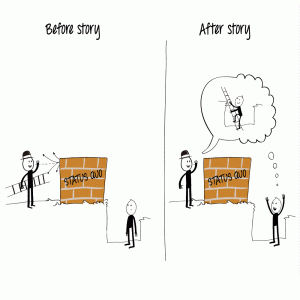 Although the value of your offering is overwhelming, customers resist. Why?
Although the value of your offering is overwhelming, customers resist. Why?
More important, how will you get past this irrational wall of resistance, and make the sale?
Not only will these questions be answered, but more important, you’ll receive a complimentary guide with simple and practical steps that you can start using today, so that you can inspire our customers to step out of the status quo, take action, and invest through you into a better tomorrow.
Overwhelmed Buyers
With 150 e-mails a day, 30 voice-mails and 60-80-hour work weeks thanks to corporate reorganizations, buyers are so busy today that in order to survive, they have learned that they can’t do it all. Consequently, buyers now often stick with the status quo—even when it hurts the company.
Logic Doesn’t Help
Product Pitches, Value Propositions and Logical Arguments do not help convince a buyer in denial to change. In fact, the buyer needs you to be wrong, in order to protect the status quo and survive.
Even if the seller makes a brilliant logical case for their offering, the buyer’s counter arguments to protect the status quo will always win, because the final judge is in the head of the buyer (click infographic).
Move Buyer from Critic to Participant with a buying simulator
So what does work? Put your message inside a series of mini customer stories, like a Trojan horse, so that they get past the Buyer’s defensive wall.
These buying simulation scenarios work for two reasons: 1) They make the abstract concrete by showing how real people solved real problems and; 2) they present a scenario that allows the Buyer to draw their own conclusions. Without feeling pressured, the Buyer can now relax and listen to your message, and possibly tell themselves a new story where new choices make more sense.
Because stories transport the buyer from the role of critic into the role of participant, they enable your buyer to take your offering out for a virtual mental test drive: Can you ask for more? (click infographic)
Here’s a hypothetical customer example: “How profitable deals later become money losers.”
 Maxine, the Supply Chain Director of Asahi Glass, wanted a way to know what orders were truly profitable.
Maxine, the Supply Chain Director of Asahi Glass, wanted a way to know what orders were truly profitable.
Up until now, the salespeople had been using a static snapshot of profitability.
Maxine, however, was disappointed to see profitable deals later become money losers, because the salespeople would place orders with no insight into how they impacted current capacity, nor if their rush order would negatively impact other orders.
Maxine needed to find a way to have a more dynamic view of profitability. Something that was simple for the salespeople to use. What she envisioned was something as simple as booking a flight online; with a number of scheduling options according to price for the customer, and true profitability for Maxine’s company.
Maxine finally had enough when a salesperson’s profitable Toyota order quickly turned into a substantial money loser, because her company was forced to fly parts into the plant to avoid delayed order penalties.
Fortunately, the Toyota order inspired Maxine to look for a solution, and she found more than what she was looking for with Advance Schedule Corp.
We provided Maxine with the ability to see each potential order’s impact on capacity, and then how it affected other orders.
But the sales team was over the moon that they could now do sales campaigns by pooling their orders along with price incentives, so that they could not just generate more sales, but more important, maintain profitability.
But that’s Maxinel’s story, what’s yours?
When necessary, the seller follows up on the buyer’s story with a few simple quantification questions, so that the buyer may cost justify their decision to change.
To start creating stories that sell, click here (or view below) for your complimentary guide.
-Michael

